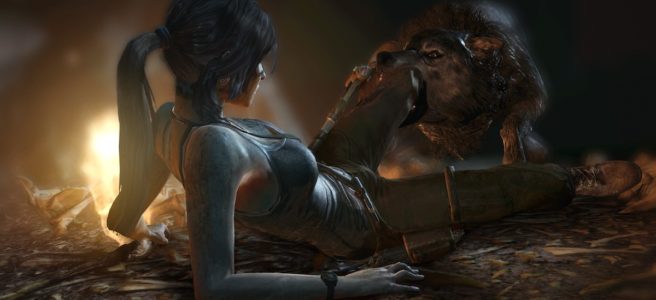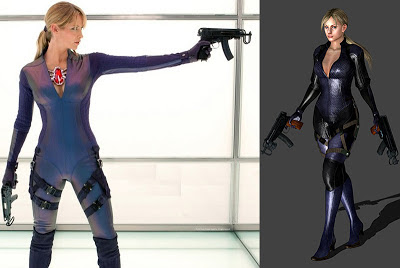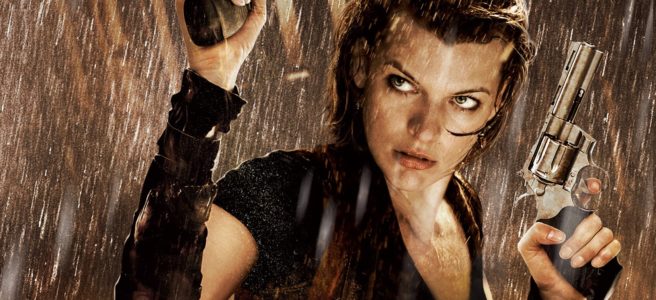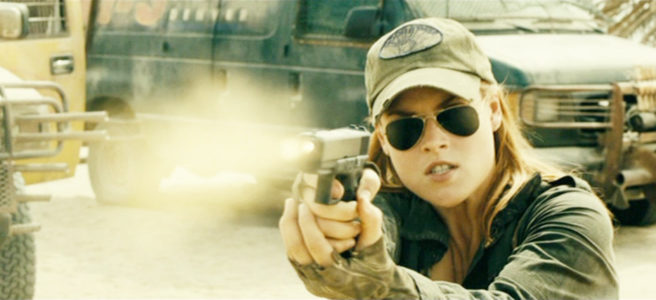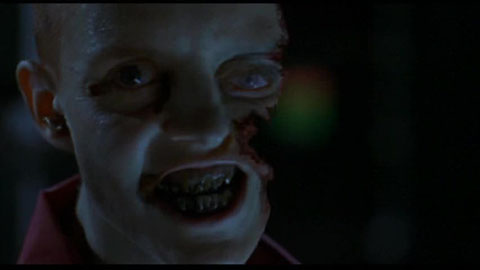Welcome back to the Planet of the Apes retrospective! In this entry we’re going to cover the sixth film in the franchise, Tim Burton’s remake of the original Planet. Quite a bit has been said about the remake over the years, but it’s been over a decade since its release – have the years changed the public reaction to it at all? Read on to find my take on it…
The ape soldiers look pretty awesome but overall it’s a pretty generic poster.
While the original Apes film series ended on a low note with Battle in 1973, the franchise continued to stay in the public conscious. Two separate TV series were released in the 70s, both of which had merchandising tie-ins. In anticipation and promotion of these TV series, Fox studios also released a Go Ape marathon of the franchise which drummed up further interest. Of course, the classic status of the original film also meant that the series was always going to be remembered, and so it was only a matter of time before the apes would rise again…
It turned out that it would take almost 15 years for a new entry in the franchise to come to light.* The first rumblings of a new Apes film came about in 1988 when Fox executives became impressed by Adam Rifkin’s Never on Tuesday. Rifkin, a huge fan of the original film, pitched a new entry in the franchise, one which would be a sequel rather than a reboot. Perhaps most intriguingly, this film would form an alternate continuity branching off from the first film and ignoring the events from Beneath onward. This sounded like an absolutely fantastic idea since the direction of the original series left so much unrealized potential that was ripe to be mined by further installments. The film was titled Return to the Planet of the Apes, was meant to allude to Spartacus and was set 300 years after the original Apes ended. The film would see the apes’ society reaching its Roman era, and would follow a descendant of Colonel Taylor, Duke. Duke would end up leading a human revolt against the apes… by all accounts, the film sounded fairly simple but also pretty damn awesome. To make matters even better, a young Tom Cruise or Charlie Sheen were both in contention for the lead role, which would have brought a lot of clout to the production. Everything seemed good to go, but days before the film was to enter pre-production, new executives arrived at Fox studios. Suddenly the film was put back into active development and Rifkin had to go through a number of rewrites until the film was unceremoniously shelved. Dammit Fox, if there’s one primary antagonist running throughout the Apes series, it’s the bloody studio heads – from meddling to budget cut-backs, the damn, dirty apes can’t get a break…
The next attempt to get the project off the ground involved one of my own personal favourite directors, Peter Jackson and his long-time collaborator/partner, Fran Walsh. Jackson and Walsh pitched their own version of the film which would see the apes undergoing their own Renaissance. The conservative ape government we witnessed in the original Apes movie would be clashing with the new arts movement as liberal apes begin sympathizing with humans. There would also be a half-human, half-ape child which would be central to the plot, an idea which was explored briefly in the development of Beneath (a tricky element to implement though, of course). To make things even better, Roddy McDowall was on board to play a Leonardo da Vinci-type ape character. Unfortunately, this version of the film failed to get off the ground as well (the executive Jackson met apparently didn’t even realize McDowall was even in the original Apes films), and thus the Apes continued to languish in development hell. That said, I’m kind of glad this version didn’t end up getting made – I’m an enormous Lord of the Rings fan and I wouldn’t trade it in it’s present (amazing) state, even for a new Apes film.
From there, Don Murphy tried to get Oliver Stone on board. Stone wasn’t interested in directing, but did sign on as an executive producer. Stone pitched a film in his trademark conspiracy theorist style… in fact it’s so confusing that I think it would be better to just copy/paste his own words rather than try to sort through it: “It has the discovery of cryogenically frozen Vedic Apes who hold the secret numeric codes to the Bible that foretold the end of civilizations. It deals with past versus the future. My concept is that there’s a code inscribed in the Bible that predicts all historical events. The apes were there at the beginning and figured it all out”. Umm ok then Oliver… Despite the rather out-there premise, the studio executives seemed to be impressed with Stone’s pitch and a screenplay by Terry Hayes titled Return of the Apes was commissioned. This script featured geneticist Will Robinson trying to cure a genetic plague, which causes all humans to have stillbirths, by going back in time. Here he discovers that humans and apes are at war and that the apes engineered the genetic plague as a time bomb of sorts in human DNA. The president of Fox studios declared that Hayes’ script was one of the best he had ever read, and Arnold freaking Schwarzeneggar was signed on to play the lead role. Unfortunately, the studio wasn’t happy with Hayes’ script, which they felt was too serious. Instead, they wanted something campier (remember, this was the 90s – think of Batman & Robin and you’ll get an idea of the tone that was in vogue). Apparently this direction was spearheaded by studio executive Dylan Sellers who kept pushing for his “baseball scene”: “What if Robinson finds himself in Ape land and the Apes are trying to play baseball? But they’re missing one element, like the pitcher or something . . . Robinson knows what they’re missing and he shows them, and they all start playing”. Ugh, I don’t even… sigh. Unfortunately, when Hayes turned in his next rewrite of the script and didn’t include Sellers’ precious baseball scene, he was fired and the entire enterprise crumbled once again. As confusing as the initial pitch was, it sounded like there was some real potential in this iteration of the production and it’s unfortunate that it wasn’t allowed to see the light of day.
After the Oliver Stone iteration of the film failed, it seemed that Fox still wanted to pursue a campy tone for the series (there were reports of makeup tests in which apes were seen skiing). Chris Columbus (known for Home Alone, Mrs. Doubtfire and the first two Harry Potter films) was brought on to direct a new script which was more closely based on Pierre Boulle’s original Apes novel than the previous films had been. This one featured an ape astronaut landing on Earth and releasing a deadly virus. Two humans use the ape’s spacecraft to return to its homeworld to find cure for the virus, finding a planet where the apes hunt humans. When they get the antidote, the heroes return to Earth to discover that the planet has been conquered by the apes in their absence (which is actually the original ending of the book). However, there were still misgivings about the script (for good reason) and so a series of directors became attached and then dropped out. Among these directors were Ronald Emmerich, James Cameron (!!!) and Peter Jackson (again).

The film finally began to take shape in 1999 when William Broyles Jr. turned in a script which caught the attention of Tim Burton. Richard Zanuck, who greenlit the original Apes film way back in 1968, signed on as producer since it was a very personal project for him to see the remake through. Unfortunately, Burton budgeted the script at $200 million (an exorbitant amount at the time), but Fox would only grant him $100 million to work with. Burton and Fox clashed quite frequently throughout production, as the studio had a very firm release date, forcing Burton to rush the shooting, editing and visual effects. Considering that it took them over 10 years to even get the film into pre-production, you think they could have afforded him at least another year to make it properly… Makeup effects wizard Rick Baker, famous for such impressive makeup-heavy films as An American Werewolf in London, was brought on to do the ape costumes, with Burton aiming for a more realistic take than any previous Apes film had attempted.
For the cast, Mark Wahlberg was cast as the lead, Leo Davidson. Currently he’s easily one of the biggest movie stars in the world, but at the time his star was still rising quickly. If you’re familiar with his work then you know he can be a great actor (Boogie Nights, Three Kings, The Fighter, etc), but his main issue is that he’s as good as his script… and he doesn’t necessarily pick the best projects to embark on either… Tim Roth (Reservoir Dogs, The Incredible Hulk) was cast as the lead villain, General Thade, a sadistic chimpanzee warrior. Rounding out the lead cast was Helena Bonham Carter (Fight Club, Harry Potter) as Ari, an ape sympathetic to the humans’ cause. Also cast were Michael Clarke Duncan, Estella Warren and Paul Giamatti, with Charlton Heston and Linda Harrison in cameo roles.

Moving onto the film itself, the plot concerns an American astronaut, Leo Davidson, who works with chimpanzees on the research space station, Oberon. When the Oberon encounters an electromagnetic storm IN SPACE, Leo’s favourite chimpanzee, Pericles, is set in a spacecraft to investigate. When things go wrong, Leo disobeys orders and attempts to retrieve Pericles, but ends up crash landing on a mysterious planet where apes hunt the humans. Leo quickly escapes their clutches and makes for the sacred ruins of Calima to link up with the Oberon before the bloodthirsty chimpanzee, General Thade, goes to war and destroys all of the damn, dirty humans. Now that might sound like a half-decent plot in summary, in practice it is pretty damn inadequate. On one hand, there’s a lot of things that just don’t make sense (why send an expensive, trained chimpanzee into the mysterious electromagnetic storm instead of a cheap, unmanned drone?). There’s also lots of massive plot conveniences (why would the human-hating Thade love Ari when she’s staunchy pro-human? Why does Thade kill the two gorillas who saw Leo’s ship crash, other than to make him appear to be super evil? Why introduce Leo’s gun and then destroy it minutes later if only to make the plot work? How the hell does the power still work in Calima (they say it’s a nuclear power core, but considering how in ruins it is, how are the electronics still in a functional state…)? Simply put, the plot is quite simple, but it’s undermined by a story that lacks logic and gravitas.
The next major problem with the film is that the characters are all paper-thin, totally undeveloped, useless or one-note. As a result, we don’t really give a shit about what’s happening or when one of them dies. Leo Davidson’s a boring main character who we honestly do not learn a single damn thing about (except that he loves his chimpanzee). Predictably, Mark Wahlberg doesn’t have a good script to work with and so his acting really suffers as he runs around with that constipated look he has in half his filmography. Estella Warren’s character Daena is a totally generic love interest and while she’s a (ridiculously) pretty face, she might just be even more useless than Nova was in the original Apes film. Ari and Thade are both completely one-dimensional (although Thade’s at least enjoyable because Tim Roth really hams it up to delightful levels). Colonel Attar and General Krull are both interesting because the pair have a rivalry with each other, but it is so poorly integrated into the plot that it has no real resonance (and Krull dies so poorly that it’s ridiculously anti-climactic). The other characters are practically useless and equally half-baked, with Paul Giamatti’s Limbo being probably the most egregious offender – he does absolutely nothing and is just tagging along to be comic relief. That said, Charlton Heston’s cameo is pretty cool, and I do not think he deserved his Razzie award in the slightest – his win was probably more due to his NRA politics at the time than his actual acting (which was serviceable, although the script was characteristically shitty here).

There’s also smaller problems with the script which further hurt the film. For one, the humans can talk in this film, but it’s not established until well after they first appear. Since this is a remake of Planet of the Apes, the audience expects the humans to be silent, so when they suddenly just start talking to one another it is a bit of an (unintentional) shock. It’s also just plain doesn’t make a lot of sense either because if the humans and apes speak the same language and express themselves just as well, how can the apes possibly sustain their belief that humans are inferior for thousands of years? On top of that, if the humans can speak and are just as intelligent as the apes, why haven’t they staged a revolution and armed themselves yet? This one little change just causes too many problems which no effort has been put in to address. The movie also completely jettisons the satirical elements which had been prevalent in nearly every previous Apes film, replacing them with more superficial racial overtones. While this isn’t a death knell by any means for a remake (eg, the Evil Dead remake jettisoned the humour and still made for an effective and intense horror film), the satirical elements were a key component of the original films and so dumbing the film down and playing it straight really feels like a betrayal of the concept. Another complaint is more of a very minor one, but the apes in this film are even more primitive than those in the original film, and yet they are more modern sociologically (eg, religion isn’t in vote, they’ve formulated the concept of evolution, etc). It’s kind of nitpicking, but I hate how historical/fantasy/sci-fi films often casually force modern ideas without good reason (eg, Orlando Bloom’s secular knight in Kingdom of Heaven). It just seems to me that Planet of the Apes was in serious need of a rewrite but the studio forced it into production too quickly, perhaps in fear that it would continue to languish in development hell.
The another problem with the film is its pacing (probably in part due to Tim Burton’s minuscule 3 month editing deadline). The film doesn’t waste any time with something as unnecessary as “set-up”. For example, as soon as Leo lands on the planet, he’s instantly being hunted by the apes (who show up about 15 seconds after the first human is glimpsed). On top of that, the humans escape the apes only 40 minutes in – in the original, the apes were only just showing up by that point. The breakneck pace makes events like the hunt lose all of their shock value, forces obvious plot conveniences and just further makes the story feel inconsequential to the action.

On the positive side, Rick Baker’s ape costumes are FANTASTIC. Seriously the makeup effects are almost perfect and the actors really do look like real apes. There aren’t even weak spots like in the sequels where background apes have noticeably inferior costumes – I didn’t notice any extras who looked bad. That said, I’m not a fan of the female chimpanzees’ design, especially Ari’s – they look frighteningly similar to Michael Jackson. I also think that General Krull might have the worst-looking costume in the whole film… it’s still pretty good but doesn’t look as realistic as the other costumes and I think it makes him look more like a wookie than a gorilla. It’s also cool to see the apes have actual ape mannerisms like jumping around during fights rather than just being cumbersome like a human. This should also go without saying, but the special effects vastly eclipse previous Apes films and still look pretty damn good 12 years after the film was released (perhaps in part because they are used sparingly and intelligently). Danny Elfman’s score also has to get a shout out for being quite effective and primal, much like Jerry Goldsmith’s original score.
The film’s climax, the final battle between apes and humans, is also a highlight. It’s a pretty damn awesome sequence, especially the fuel cell “bomb”, but it’s really the only plot highlight in the film. The battle itself is exciting, if muddled and lacking in emotion. However, it also doesn’t make a lot of sense that when the battle ends the humans and apes are suddenly all friends with each other without any lingering tensions whatsoever. That said, while it could have been better, the final battle is definitely a cool sequence.

Of course, there’s one element I’ve been purposefully withholding up until this point and that’s the film’s ending. Obviously trying to riff on the original Apes‘ classic ending, the remake tried to throw in a twist of its own (doubly so because twists were in vogue at this period thanks to The Sixth Sense). Unfortunately, the remake must have one of the absolute worst twist endings I’ve ever seen. It’s so incredibly stupid and nonsensical. Leo leaves the planet of the apes and returns through the electromagnetic storm to Earth. He crashes his ship in front of the Lincoln memorial and discovers that somehow Thade beat him back to Earth and apes now rule the planet… WTF!?! Okay, this has to be broken down somewhat because it’s just that confusing. For one thing, yes, this is how the original Boulle novel ended. However, the changes made in the remake make Boulle’s ending a bad fit for this film. For one thing, ditching the satire makes this ending have no sort of comeuppance or logic. For another thing, there is absolutely nothing to allude to this ending and so it just comes out of nowhere and is given zero explanation.
That said, there is an “official” explanation which makes it make some sense, but it’s still pretty inadequate in my opinion. This explanation involves the “logic” of time travel in the remake – things which enter the magnetic storm come out the other side in inverse order (hence why the Oberon arrives thousands of years before Leo Davidson). As a result, when Leo leaves the planet, Thade somehow escapes Calima and recovers Leo’s ship, beating him to Earth in the process. Obviously you can see some pretty gaping logic gaps here (how did Thade escape, pilot the ship, conquer Earth, etc), but the bigger problem is much more simple – this explanation of time travel only works in a story. I mean, we only follow three objects going into and out of the storm, but obviously other things are going to pass through here and mess up the theory. On top of that, what (aside from plot convenience) determines when objects emerge from the storm? Pericles arrives only days after Leo after all. On top of all of this, how is the audience expected to think up all of this stuff to make the ending make a modicum of sense? People who think it’s a very clever ending are deluding themselves – the Apes remake has an indefensibly terrible ending which is an insult to the audience’s intelligence.
So all-in-all, I think you can tell that I don’t like the Planet of the Apes remake. In fact, it gets worse every time I see it. However, I do owe it a debt of gratitude because I probably would never have seen the original without it – close to its release the 1968 classic was on TV and I watched it with my family… and the rest is history as they say. It might be better-made than Battle, but the Apes remake is a hollow husk of weak characters and a crappy plot with a totally idiotic ending to boot.
3/10
Be sure to come back soon for part 7 of this retrospective series as we wrap up with Rise of the Planet of the Apes!
*Research on the development/production process comes from David Hughes’ fascinating insight on the Hollywood machine, Tales From Development Hell and from the remake’s Wikipedia page.
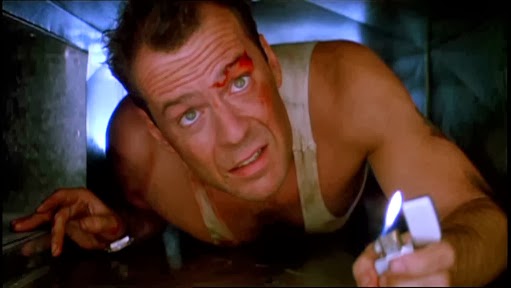





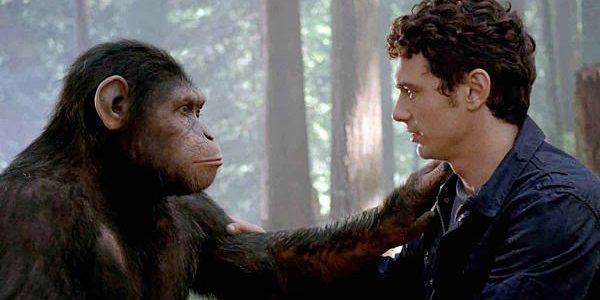






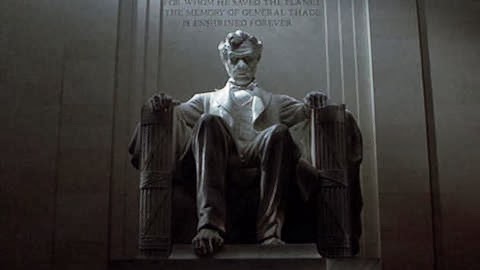






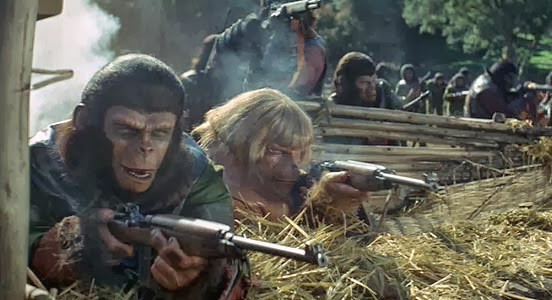




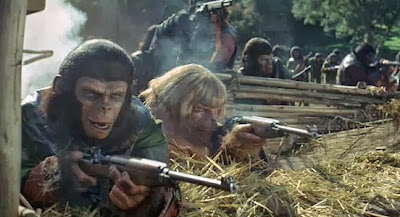

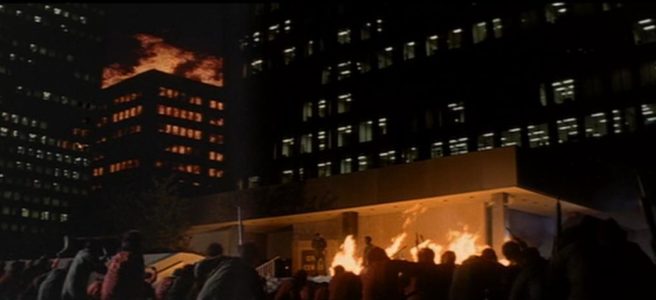







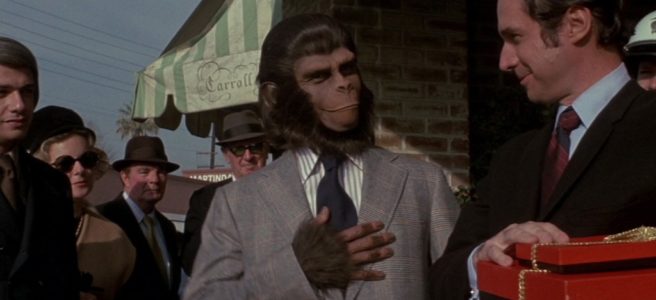





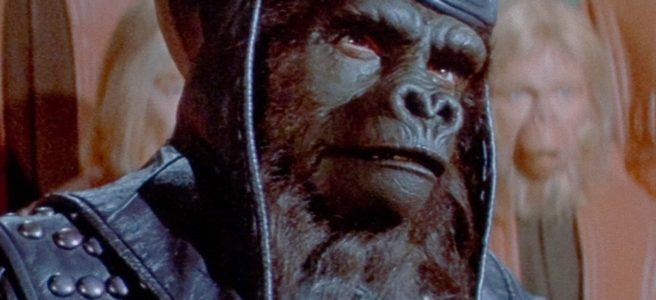










.jpg)
